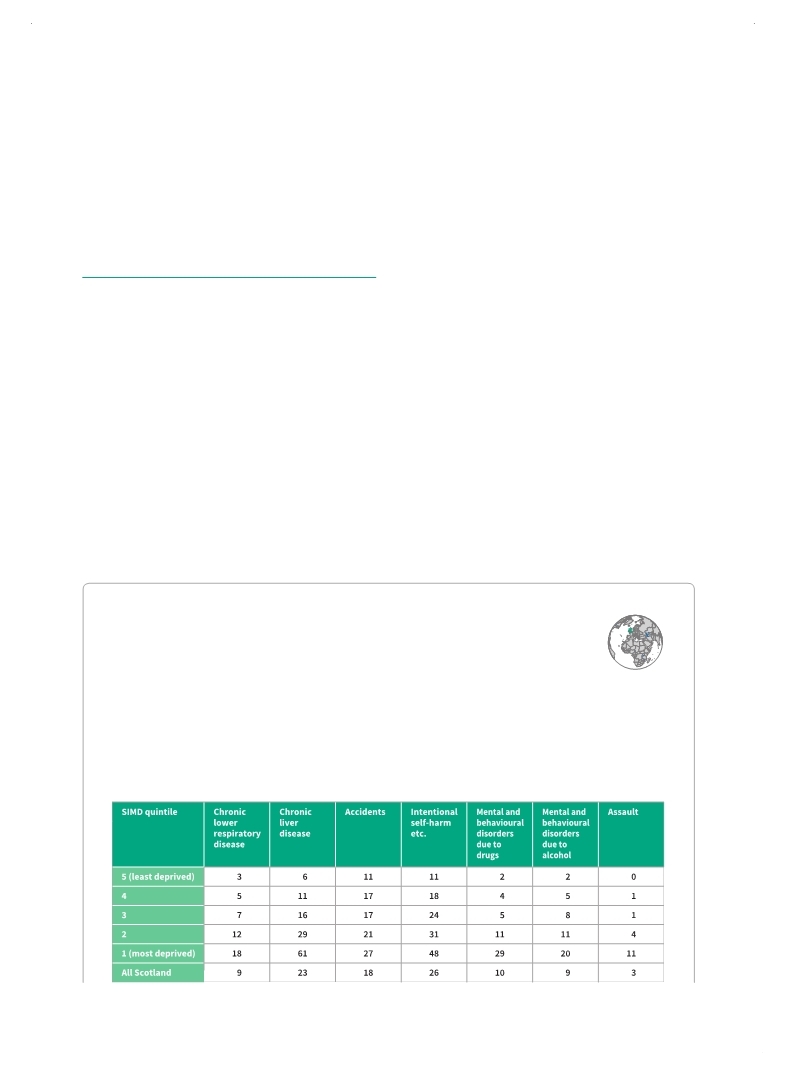 |
Global Assessment Report on Disaster Risk Reduction 2015
Making development sustainable: The future of disaster risk management |
 |
Global Assessment Report on Disaster Risk Reduction 2015
Making development sustainable: The future of disaster risk management |
|
|

Box 9.1 Everyday and extensive risk in Calton
184
Part III - Chapter 9
9.1 Multi-dimensional poverty,
everyday risks and disasters
Multi-dimensional poverty experienced in hazard-exposed areas means that conditions of everyday risk become configured as patterns of extensive disaster risk.
In the wealthy town of Lenzie, East Dunbartonshire, Scotland, men live to an average age of 82. Just 12 kilometres down the road, in Calton, Glasgow, they die at 54 on average (Government of Scotland, 2009
Government of Scotland. 2009,National Forum on Drug Related Deaths in Scotland Annual Report 2008-09, Edinburgh: The Scottish Government.. . Table 9.1 Male mortality (age 0-64, per 100,000) from selected causes within each SIMD deprivation quintile, 2000-2002.
(Source: UNISDR with data from the SIMD.4)
can expect to live until the age of 71,1 or in Iraq, where after 20 years of sanctions and war, male life expectancy is 66 years.2 Only 12 countries in sub-Saharan Africa, including Sierra Leone, Chad and the Democratic Republic of Congo have a lower male life expectancy than Calton.3 Given the link between poverty and disaster risk, it may come as no surprise that Calton also sees regular flooding (Box 9.1).
The case of Calton epitomizes how economic poverty, together with other poverty factors such as powerlessness, exclusion, low literacy and discrimination, translates into conditions
The concentration of capital generates social and territorial inequalities. The world is nearing what can be considered absolute levels of inequality, and sectors and territories without comparative advantages for capital accumulation are being left behind. In those areas, disaster risk is associated with an absence of development characterized by low levels of investment in risk-reducing infrastructure, an absence of social and environmental protection, and rural and urban poverty.
Calton is an underprivileged district in Glasgow, Scotland. Poverty, drugs and alcohol, crime and poor health are rampant. A full 44 per cent of its inhabitants are on incapacity benefits and 37 per cent live in workless households (Government of Scotland, 2009
Government of Scotland. 2009,National Forum on Drug Related Deaths in Scotland Annual Report 2008-09, Edinburgh: The Scottish Government.. . In Scotland, mortality due to causes such as respiratory and liver diseases, accidents, drug and alcohol-related disorders, self-harm and assault in the most deprived areas like Calton are higher than in the least deprived areas by an order of magnitude on the Scottish Index of Multiple Deprivation (SIMD; Table 9.1). |
 
Page 1Page 10Page 20Page 30Page 40Page 50Page 60Page 70Page 80Page 90Page 100Page 110Page 120Page 130Page 140Page 150Page 160Page 170Page 174Page 175Page 176Page 177Page 178Page 179Page 180Page 181Page 182Page 183Page 184Page 185->Page 186Page 187Page 188Page 189Page 190Page 191Page 192Page 193Page 194Page 195Page 196Page 197Page 198Page 200Page 210Page 220Page 230Page 240Page 250Page 260Page 270Page 280Page 290Page 300Page 310
|
|
 
|
 
|
